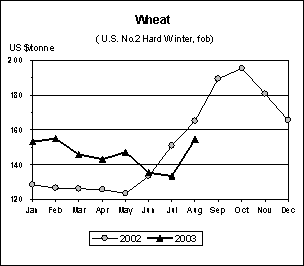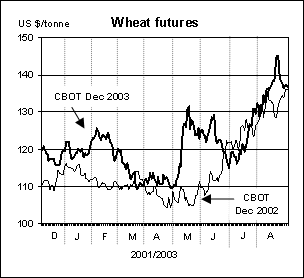Cereals: Export Prices
Cereal prices mostly higher, but prospects are mixed
|
 |
| | 2003 | 2002 | | | August | May | August | | | (US$/tonne) | |
United States | | | | | Wheat | 155 | 147 | 165 | | Maize | 100 | 108 | 110 | | Sorghum | 106 | 103 | 115 | |
Argentina | | | | | Wheat | 155 | 157 | 138 | | Maize | 98 | 104 | 106 | |
Thailand | | | | | Rice white | 198 | 202 | 195 | | Rice, broken | 151 | 143 | 149 |
* Prices refer to the monthly average. For sources see Appendix Tables A.6 and A.7.
International wheat prices have increased steadily since the start of the season in July, driven upward by worries about supply shortfalls in Europe. However, while repeated cuts in this year’s crop estimates in the EU and a general supply tightness across Europe have pushed up prices, weak world import demand and strong supply rebound in the United States, Australia and Canada have prevented prices from increasing more significantly. In August, the US wheat No. 2 HRW averaged US$155 per tonne, up US$8 per tonne from May, but still US$10 per tonne below the corresponding month last year. Over the past two months, the US futures also made substantial gains, reacting mainly to crop concerns. However, after soaring to 11-month highs in mid-August, wheat futures for December 2003 delivery at the Chicago Board of Trade (CBOT) lost most of the gains made during the first half of the month, reaching US$137 per tonne, up slightly from the previous year. Looking ahead, wheat prices are more likely to stabilize at current levels, and may even decline rather than rise much further, due to larger supplies among major exporters and sliding demand in several leading wheat importing countries as a result of bumper crops.
  In the maize market, prices have followed a steady downward trend over the past two months, mostly from good crop prospects in the United States, a bumper harvest in Brazil and continued large sales by China. However, this year’s lower supplies of feed wheat in international markets and the strengthening of world wheat prices have been generally supportive to maize prices. In August, US maize export price (US No. 2 Yellow) averaged US$100 per tonne, down US$8 per tonne since May and US$10 per tonne below the corresponding month last year. The expected rebound in the US maize crop has been the main factor contributing to the weakness in the futures market. The December 2003 maize futures at CBOT continued to remain below the previous year’s level and by late August they were quoted at US$93 per tonne, US$15 per tonne below the corresponding month last year. With the approach of the harvest in major northern-hemisphere producing regions, and with weather problems becoming less threatening, maize prices are more likely to continue under downward pressure in the coming months, although strong demand for feed gains may help to underpin prices to some extent.
  International rice prices have risen steadily since May, as reflected in the FAO Rice Export Price Index, which passed from 80 points in May, to 82 points in June, 83 in July and 85 in August. This strength reflects mainly a tightening of supplies in some major exporting countries, in particular Australia, India, Pakistan and the United States, where quotations were higher; but also a sustained import demand, especially from countries in Latin America and the Caribbean and in the Near East. By contrast, the termination of the government procurement programme in Thailand at the end of July tended to depress export prices there in August. The arrival on the market of the summer/autumn crop in Viet Nam has also tended to lower the country’s rice quotations since May.
|
 |
Among the different types of rice traded, international quotations experienced the sharpest increases for medium-grain rice, with the FAO Japonica index climbing 11 points over the period from 77 in May to 88 in August. Much of the momentum was fuelled by scarcities in the three major medium-grain rice suppliers, namely Australia, China, Egypt and the United States at a time when rice is needed to fill import tenders by the Republic of Korea, the Chinese Province of Taiwan and Japan. The increase was particularly strong in the case of the US No. 2, 4% husked medium-grain rice, which rose by US$43 per tonne from US$230 per tonne in May to US$273 per tonne in August.
As for high-quality Indica, quotations from Pakistan and the United States strengthened steadily between May and August, while the price of the Thai 100%B dropped to US$198 per tonne in August, after reaching a high of US$209 per tonne in June. As a result of the diverging price movements, the price difference between the United States and Thailand high-quality rice widened to US$107 per tonne in August, compared with US$85 per tonne in May. Overall, the FAO price index for high-quality Indica rice was up from 79 in May to 80 in June and July and to 82 in August.
Similarly, prices of lower-quality Indica rice also showed some moderate increases, reflected in a rise of 3 points in the FAO Low Quality Indica Price Index between May and August. The price strength stemmed mainly from higher quotations for 25% broken rice from Pakistan and India, while the same price showed a lower trend in Viet Nam.
On the aromatic rice market, prices continued on a steady upward trend which raised the index by 5 points to 97 between May and August, or close to the level prevailing in the index base period (1998–2000). The vigour was felt in all three major aromatic rice markets: Pakistan Basmati, Indian Basmati and Thailand fragrant, which gained between US$25 and US$30 per tonne between May and August.
Prospects for international rice prices over the coming months point to renewed strength in view of a possible surge in import demand. Several exporters have intensified efforts to widen their markets in various geographical locations, which – combined with relatively limited availabilities – could bolster prices well beyond the low levels that have characterized the market since 2000. However, the price pattern will become more definite when the results of the main paddy crops are released.
|





